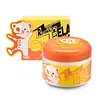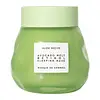What's inside
What's inside
 Key Ingredients
Key Ingredients

 Benefits
Benefits

 Concerns
Concerns

 Ingredients Side-by-side
Ingredients Side-by-side

Swiftlet Nest Extract
Skin ConditioningMacadamia Integrifolia Seed Oil
Skin ConditioningBeeswax
Emulsion StabilisingCetyl Alcohol
EmollientGlycerin
HumectantPolysorbate 60
EmulsifyingDipropylene Glycol
HumectantRetinol
Skin ConditioningSh-Oligopeptide-1
Skin ConditioningSodium Polyacrylate
AbsorbentAllantoin
Skin ConditioningPEG-100 Stearate
Adenosine
Skin ConditioningCarbomer
Emulsion StabilisingBetaine
HumectantPropylene Glycol
HumectantCaprylic/Capric Triglyceride
MaskingPolysorbate 20
EmulsifyingArginine
MaskingAlcohol
Antimicrobial1,2-Hexanediol
Skin ConditioningCeteth-3
EmulsifyingBrassica Campestris Sterols
EmollientTocopheryl Acetate
AntioxidantCetyl Phosphate
EmulsifyingCholesterol
EmollientPEG-5 Rapeseed Sterol
CleansingHydrogenated Lecithin
EmulsifyingEthylhexylglycerin
Skin ConditioningWater
Skin ConditioningSorbitan Sesquioleate
EmulsifyingCeteth-5
EmulsifyingDisodium EDTA
Glyceryl Stearate
EmollientParfum
MaskingSwiftlet Nest Extract, Macadamia Integrifolia Seed Oil, Beeswax, Cetyl Alcohol, Glycerin, Polysorbate 60, Dipropylene Glycol, Retinol, Sh-Oligopeptide-1, Sodium Polyacrylate, Allantoin, PEG-100 Stearate, Adenosine, Carbomer, Betaine, Propylene Glycol, Caprylic/Capric Triglyceride, Polysorbate 20, Arginine, Alcohol, 1,2-Hexanediol, Ceteth-3, Brassica Campestris Sterols, Tocopheryl Acetate, Cetyl Phosphate, Cholesterol, PEG-5 Rapeseed Sterol, Hydrogenated Lecithin, Ethylhexylglycerin, Water, Sorbitan Sesquioleate, Ceteth-5, Disodium EDTA, Glyceryl Stearate, Parfum
Water
Skin ConditioningPropanediol
SolventGlycerin
HumectantCetearyl Alcohol
EmollientGlyceryl Stearate
EmollientC9-12 Alkane
SolventCaprylic/Capric Triglyceride
MaskingKaolin
AbrasivePersea Gratissima Oil
Skin ConditioningPolyisobutene
Sodium Lauroyl Glutamate
Stearic Acid
CleansingC13-15 Alkane
SolventPlatonia Insignis Seed Butter
EmollientPersea Gratissima Fruit Extract
EmollientHyaluronic Acid
HumectantSodium Hyaluronate
HumectantSqualane
EmollientChamomilla Recutita Flower Extract
MaskingCamellia Sinensis Leaf Extract
AntimicrobialSaccharide Isomerate
HumectantHexylresorcinol
AntimicrobialZingiber Officinale Root Extract
MaskingOryza Sativa Extract
AbsorbentTocopheryl Acetate
AntioxidantGluconolactone
Skin ConditioningAloe Barbadensis Leaf Juice
Skin ConditioningMalachite Extract
AntioxidantEthylhexyl Palmitate
EmollientButylene Glycol
HumectantSodium Chloride
MaskingSodium Hydroxypropylsulfonate Laurylglucoside Crosspolymer
CleansingMaltodextrin
AbsorbentHydrated Silica
AbrasiveCurcumin
AntioxidantEthylhexylglycerin
Skin ConditioningPPG-3 Benzyl Ether Myristate
EmollientMaltooligosyl Glucoside
Skin ConditioningHydrogenated Starch Hydrolysate
HumectantRetinol
Skin ConditioningSpirulina Maxima Extract
SmoothingSodium Phosphate
BufferingPei-10
Citric Acid
BufferingSodium Citrate
BufferingSodium Dilauramidoglutamide Lysine
HumectantPotassium Phosphate
BufferingPotassium Chloride
Silica Dimethyl Silylate
EmollientArginine
MaskingSodium Hydroxide
BufferingCaprylyl Glycol
EmollientTocopherol
AntioxidantRosmarinus Officinalis Leaf Extract
AntimicrobialLavandula Angustifolia Flower/Leaf/Stem Extract
MaskingHexylene Glycol
EmulsifyingAcrylates/C10-30 Alkyl Acrylate Crosspolymer
Emulsion StabilisingPotassium Sorbate
PreservativeCarthamus Tinctorius Seed Extract
Skin ConditioningAroma
Pvp
Emulsion StabilisingSodium Benzoate
MaskingPhenoxyethanol
PreservativeParfum
MaskingWater, Propanediol, Glycerin, Cetearyl Alcohol, Glyceryl Stearate, C9-12 Alkane, Caprylic/Capric Triglyceride, Kaolin, Persea Gratissima Oil, Polyisobutene, Sodium Lauroyl Glutamate, Stearic Acid, C13-15 Alkane, Platonia Insignis Seed Butter, Persea Gratissima Fruit Extract, Hyaluronic Acid, Sodium Hyaluronate, Squalane, Chamomilla Recutita Flower Extract, Camellia Sinensis Leaf Extract, Saccharide Isomerate, Hexylresorcinol, Zingiber Officinale Root Extract, Oryza Sativa Extract, Tocopheryl Acetate, Gluconolactone, Aloe Barbadensis Leaf Juice, Malachite Extract, Ethylhexyl Palmitate, Butylene Glycol, Sodium Chloride, Sodium Hydroxypropylsulfonate Laurylglucoside Crosspolymer, Maltodextrin, Hydrated Silica, Curcumin, Ethylhexylglycerin, PPG-3 Benzyl Ether Myristate, Maltooligosyl Glucoside, Hydrogenated Starch Hydrolysate, Retinol, Spirulina Maxima Extract, Sodium Phosphate, Pei-10, Citric Acid, Sodium Citrate, Sodium Dilauramidoglutamide Lysine, Potassium Phosphate, Potassium Chloride, Silica Dimethyl Silylate, Arginine, Sodium Hydroxide, Caprylyl Glycol, Tocopherol, Rosmarinus Officinalis Leaf Extract, Lavandula Angustifolia Flower/Leaf/Stem Extract, Hexylene Glycol, Acrylates/C10-30 Alkyl Acrylate Crosspolymer, Potassium Sorbate, Carthamus Tinctorius Seed Extract, Aroma, Pvp, Sodium Benzoate, Phenoxyethanol, Parfum
Ingredients Explained
These ingredients are found in both products.
Ingredients higher up in an ingredient list are typically present in a larger amount.
Arginine is an amino acid that is important for human development. Your body uses is it to produce hair keratin and skin collagen.
As a cosmetic ingredient, Arginine has antioxidant properties and can also help repair damaged skin. This ingredient is derived either synthetically or from animals.
Arginine isn't fungal acne safe when used in the presence of other lipids (fats, fatty acids, oils, esters, etc). Oils and fats occur naturally within the skin, so take caution when using Arginine if you're prone to fungal acne.
Learn more about ArginineThis ingredient is an emollient, solvent, and texture enhancer. It is considered a skin-softener by helping the skin prevent moisture loss.
It helps thicken a product's formula and makes it easier to spread by dissolving clumping compounds.
Caprylic Triglyceride is made by combining glycerin with coconut oil, forming a clear liquid.
While there is an assumption Caprylic Triglyceride can clog pores due to it being derived from coconut oil, there is no research supporting this.
Learn more about Caprylic/Capric TriglycerideEthylhexylglycerin (we can't pronounce this either) is commonly used as a preservative and skin softener. It is derived from glyceryl.
You might see Ethylhexylglycerin often paired with other preservatives such as phenoxyethanol. Ethylhexylglycerin has been found to increase the effectiveness of these other preservatives.
Glycerin is already naturally found in your skin. It helps moisturize and protect your skin.
A study from 2016 found glycerin to be more effective as a humectant than AHAs and hyaluronic acid.
As a humectant, it helps the skin stay hydrated by pulling moisture to your skin. The low molecular weight of glycerin allows it to pull moisture into the deeper layers of your skin.
Hydrated skin improves your skin barrier; Your skin barrier helps protect against irritants and bacteria.
Glycerin has also been found to have antimicrobial and antiviral properties. Due to these properties, glycerin is often used in wound and burn treatments.
In cosmetics, glycerin is usually derived from plants such as soybean or palm. However, it can also be sourced from animals, such as tallow or animal fat.
This ingredient is organic, colorless, odorless, and non-toxic.
Glycerin is the name for this ingredient in American English. British English uses Glycerol/Glycerine.
Learn more about GlycerinGlyceryl Stearate is a mix of glycerin and stearic acid.
It is used to stabilize the mixing of water and oil ingredients. By preventing these ingredients from separating, it can help elongate shelf life. It can also help thicken the product's texture.
As an emollient, it helps soften skin and supports barrier-replenishing ingredients.
In cosmetics, Glyceryl Stearate is often made from vegetable oils or synthetically produced.
This ingredient may not be fungal-acne safe
Fun fact: The human body also creates Glyceryl Stearate naturally.
Learn more about Glyceryl StearateParfum is a catch-all term for an ingredient or more that is used to give a scent to products.
Also called "fragrance", this ingredient can be a blend of hundreds of chemicals or plant oils. This means every product with "fragrance" or "parfum" in the ingredients list is a different mixture.
For instance, Habanolide is a proprietary trade name for a specific aroma chemical. When used as a fragrance ingredient in cosmetics, most aroma chemicals fall under the broad labeling category of “FRAGRANCE” or “PARFUM” according to EU and US regulations.
The term 'parfum' or 'fragrance' is not regulated in many countries. In many cases, it is up to the brand to define this term.
For instance, many brands choose to label themselves as "fragrance-free" because they are not using synthetic fragrances. However, their products may still contain ingredients such as essential oils that are considered a fragrance by INCI standards.
One example is Calendula flower extract. Calendula is an essential oil that still imparts a scent or 'fragrance'.
Depending on the blend, the ingredients in the mixture can cause allergies and sensitivities on the skin. Some ingredients that are known EU allergens include linalool and citronellol.
Parfum can also be used to mask or cover an unpleasant scent.
The bottom line is: not all fragrances/parfum/ingredients are created equally. If you are worried about fragrances, we recommend taking a closer look at an ingredient. And of course, we always recommend speaking with a professional.
Learn more about ParfumRetinol is a gold-standard ingredient for anti-aging. It is a form of Vitamin A and belongs to the class of retinoids that also includes tretinoin.
Why is retinol famous?
It has the most scientific studies backing up its skin benefits out of all the non-prescription ingredients.
Retinol is proven to:
This is why retinol is effective at removing wrinkles, fading dark spots, treating acne, and reducing the appearance of pores.
Studies show retinol is less effective when exposed to UV. Be sure to look for appropriate packaging to keep your retinol potent (similar to Vitamin C).
Using retinol or any retinoids will increase sun-sensitivity in the first few months. Though studies show retinoids increase your skin's natural SPF with continuous use, it is best to always wear sunscreen and sun-protection.
We recommend speaking with a medical professional about using this ingredient during pregnancy.
Retinol may cause irritation in some people, so be sure to patch test. Experts recommend 'ramping up' retinol use: start using this ingredient once a week and work up to using it daily.
Read about Tretinoin
Learn more about RetinolTocopheryl Acetate is AKA Vitamin E. It is an antioxidant and protects your skin from free radicals. Free radicals damage the skin by breaking down collagen.
One study found using Tocopheryl Acetate with Vitamin C decreased the number of sunburned cells.
Tocopheryl Acetate is commonly found in both skincare and dietary supplements.
Learn more about Tocopheryl AcetateWater. It's the most common cosmetic ingredient of all. You'll usually see it at the top of ingredient lists, meaning that it makes up the largest part of the product.
So why is it so popular? Water most often acts as a solvent - this means that it helps dissolve other ingredients into the formulation.
You'll also recognize water as that liquid we all need to stay alive. If you see this, drink a glass of water. Stay hydrated!
Learn more about Water